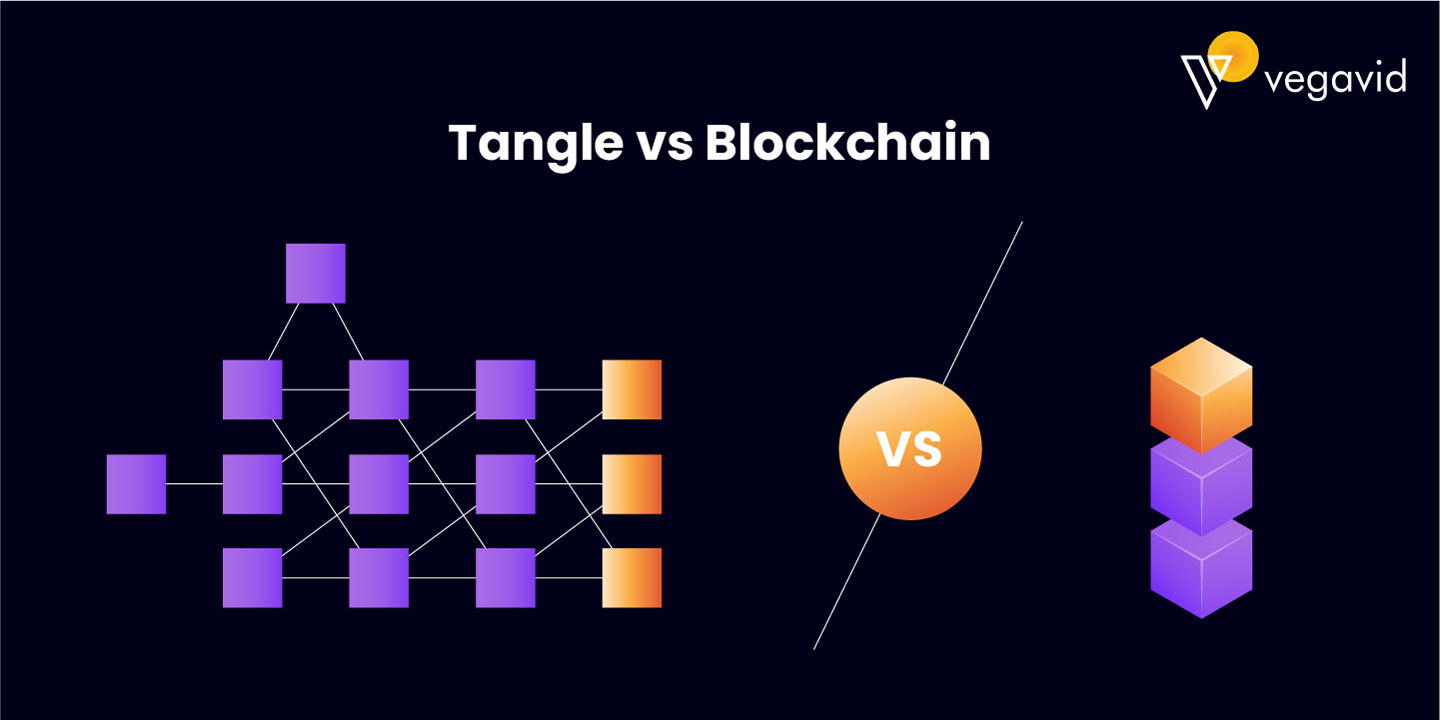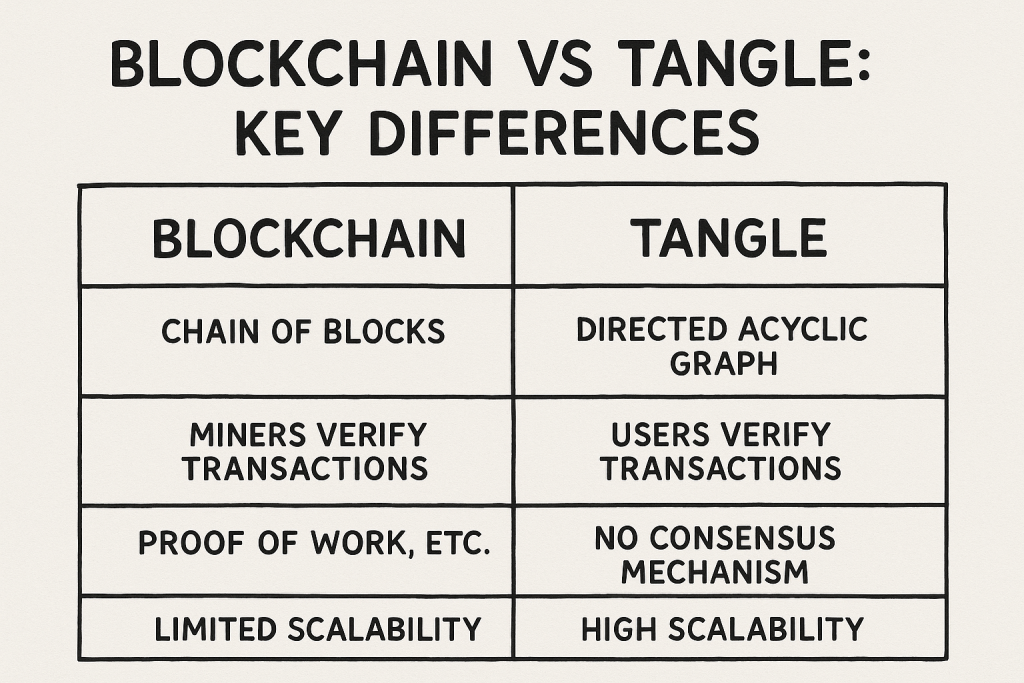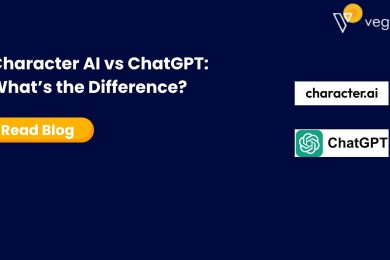
The rapid rise of cryptocurrency and decentralized technologies has brought with it not only innovation but also the need for new and more efficient infrastructure. While Blockchain remains the most recognized form of distributed ledger technology (DLT), alternatives like Tangle, developed by the IOTA Foundation, are gaining traction due to their distinct architecture and features.
In this guide, we’ll break down the differences between Blockchain and Tangle, explore their respective advantages, real-world applications, and future potential, so you can better understand which technology might be best suited for specific use cases.
What is Blockchain?
Blockchain is a decentralized, immutable digital ledger that stores data in blocks, linked together chronologically to form a chain. Each block contains a list of transactions that are verified by network participants known as miners or validators, depending on the consensus mechanism (e.g., Proof of Work, Proof of Stake). Here are some Key Characteristics of blockchain:
- Linear chain of blocks
- Requires miners/validators
- Typically incurs transaction fees
- Secure and transparent
- Slower scalability due to consensus mechanisms
What is Tangle?
Now for our other distributed ledger, Tangle. Created by the IOTA Foundation, Tangle addresses some perceived limitations in blockchain technology for the “Internet of Things” (IoT). Whereas blockchain transactions are grouped into blocks, the Tangle has a directed acyclic graph (DAG) structure where transactions directly approve two previous transactions in the network.In simpler terms, each transaction in the Tangle crypto confirms two other previous ones, forming a unique “tangled” web of data. Unlike Blockchain, transactions don’t have to wait to be grouped into blocks before getting validated. Proponents argue this makes the Tangle faster and more scalable to handle the massive transaction volumes expected from IoT devices.
Tangle stands as an innovative distributed ledger technology powering the infrastructure of the IOTA cryptocurrency network. Unlike traditional blockchain architectures, Tangle introduces a Directed Acyclic Graph (DAG) structure, offering a unique approach to achieving consensus and facilitating transactions in a decentralized ecosystem.
At its core, Tangle represents a network of interconnected transactions rather than a linear chain of blocks, as seen in conventional blockchains. In this mesh-like structure, each new trade in the Tangle network directly verifies and approves two previous transactions. This distinctive feature eliminates the need for miners or validators to confirm transactions, significantly altering the consensus model.
The process of transaction validation in Tangle is interconnected and collaborative. When a new transaction enters the network, it must validate two previous transactions by performing a small amount of proof of work. As a result, Tangle operates on the principle of ‘give and take,’ where transactions validate other transactions, forming a web of interdependencies.
One of the most notable advantages of Tangle over Blockchain lies in its potential for scalability and speed. Unlike traditional blockchains that may experience congestion and slower transaction times as the network grows, Tangle’s structure theoretically enables higher throughput as the number of network participants increases. This scalability feature positions Tangle as a promising solution for applications requiring high transaction volumes, particularly in the Internet of Things (IoT) realm, where numerous microtransactions and real-time data processing are essential.
Moreover, Tangle’s design has the potential to facilitate feeless transactions, which can be highly advantageous for scenarios involving numerous microtransactions or small value transfers.
Overall, Tangle’s Directed Acyclic Graph structure represents a departure from the conventional blockchain architecture, offering a new paradigm for achieving decentralized consensus and addressing key challenges such as scalability, transaction speed, and potentially enabling feeless transactions, thus fostering innovation in various industries beyond cryptocurrencies.
Blockchain vs Tangle: Key Differences

The comparison between blockchain and Tangle, the underlying technology behind IOTA, delineates two distinct approaches to achieving decentralized consensus and facilitating transactions.
Architecture:
Blockchain: Operates as a linear chain of blocks, where each block stores a batch of transactions. Transactions are verified and added to the chain through mining or staking mechanisms.
Tangle: Utilizes a Directed Acyclic Graph (DAG) structure, a mesh-like network where each transaction validates two previous transactions. Tangle diverges from the linear chain structure, offering a more scalable and seamless transaction environment.
Consensus Mechanisms:
Blockchain: Relies on consensus mechanisms like PoW or PoS, where miners or validators compete to solve cryptographic puzzles or stake assets to validate transactions.
Tangle: Functions on a different consensus model where each transaction validates other transactions. It eliminates the need for miners or validators and allows faster and potentially more scalable transactions.
Scalability and Transaction Speed:
Blockchain: Faces scalability challenges due to block size limitations and consensus mechanisms. It impacts transaction speed and increases fees during network congestion.
Tangle: Tangle’s structure theoretically allows for increased scalability as the network grows, potentially improving transaction throughput without encountering congestion or increased fees and promoting microtransactions and IoT applications.
Understanding these critical differences between blockchain and Tangle showcases the varying architectures and consensus mechanisms that underpin decentralized technologies. While blockchain emphasizes security and established consensus methods, Tangle seeks to address scalability and transaction speed concerns, opening doors to innovative applications in the rapidly evolving landscape of decentralized systems.
Now let’s examine a few of the main differences between these innovative distributed ledgers:
- Structure – As mentioned, Blockchain uses a linear chain of blocks, whereas Tangle has a more free-flowing directed acyclic graph structure.
- Confirmation – In Blockchain, miners bundle transactions into blocks and solve problems to confirm them. Tangle users directly approve two previous transactions.
- Fees – Blockchain miners charge fees. The Tangle is designed to have no fees since no miners require payment.
- Centralization – Blockchain is highly decentralized by design. Tangle uses “coordinator nodes,” which some argue makes it less so currently.
- Scalability – The Tangle claims to be more scalable than Blockchain for IoT due to its parallel processing ability. Remains to be proven at massive scales.
While both ledgers aim to decentralize digital transactions, the Tangle takes a novel graph approach versus Blockchain’s linear chained blocks. Let’s dive deeper into their similarities and differences.
Advantages of Blockchain vs Tangle
| Feature | Blockchain | Tangle (IOTA) |
|---|---|---|
| Security | Secure via cryptographic consensus (PoW/PoS) | Secure through cumulative transaction validation (DAG-based ledger) |
| Transaction Fees | Established networks; supports high-value transactions | Feeless cryptocurrency transactions ideal for IoT payments |
| Adoption | Widely used in DeFi, NFTs, digital identity systems | Emerging tech focused on Internet of Things cryptocurrency |
| Energy Efficiency | Energy-heavy (especially PoW-based like Bitcoin) | Energy-efficient and suitable for M2M payments and microtransactions |
| Scalability | Slower due to block creation & mining delays | Highly scalable; performance increases with network activity (DAG technology) |
Use Cases of Blockchain vs Tangle
| Use Case | Blockchain | Tangle (IOTA) |
|---|---|---|
| Decentralized Finance (DeFi) | Powering DeFi platforms like Aave and Uniswap | Less suitable due to low liquidity and developer adoption |
| Supply Chain Management | Tracking and authenticating goods across global supply chains | Real-time data verification in smart logistics systems |
| Smart Contracts & NFTs | Widely used on platforms like Ethereum and Solana | Not yet optimized for complex smart contracts or NFTs |
| Smart Cities | Basic integration in public systems | Real-time IoT microtransactions for parking, lighting, and environmental data |
| Automotive / M2M Payments | Limited direct use | Car-to-car communication using Tangle DAG; Jaguar Land Rover pilot |
| Energy Trading | Tokenizing energy credits in blockchain grids | Peer-to-peer energy trading via smart meters and IoT sensors |
Challenges of Blockchain vs Tangle
| Challenge | Blockchain | Tangle (IOTA) |
|---|---|---|
| Transaction Fees | High gas fees, especially on Ethereum and Bitcoin | Zero fees, but limited exchange and wallet support |
| Scalability | Network congestion slows performance | Scalability improves with usage but lacks mature adoption |
| Environmental Impact | PoW blockchains are resource-intensive | Energy-efficient DAG structure optimized for low-power devices |
| Decentralization | Some blockchains becoming centralized via validator dominance | Still reliant on “Coordinator” node (moving toward Coordicide) |
| Developer Ecosystem | Large and active across Ethereum, Solana, etc. | Smaller ecosystem; fewer tools for smart contract and dApp development |
Real-World Comparisons
| Use Case | Better With Blockchain | Better With Tangle |
|---|---|---|
| Large Financial Systems | ✅ | ❌ |
| IoT Microtransactions | ❌ | ✅ |
| NFT Marketplaces | ✅ (Ethereum, Solana) | ❌ |
| Smart Cities | ❌ | ✅ |
| Secure Voting | ✅ | ❌ |
| M2M Payments | ❌ | ✅ |
Which One Should You Use?
There’s no one-size-fits-all answer. Your choice between Blockchain and Tangle depends on your specific requirements:
- For financial, secure, and widely supported applications → Choose Blockchain
- For IoT, machine-to-machine communication, and microtransactions → Explore Tangle (IOTA)
As technology evolves, we may see both systems working in tandem, complementing each other’s strengths to power a more decentralized future.











